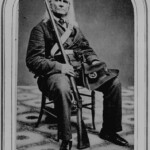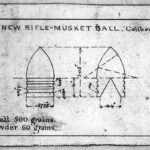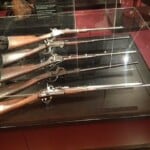
Introduction
The history of firearms is filled with innovations that have reshaped warfare, but few rifles stand out as distinctly as the .451 Whitworth Rifle. Designed by British engineer Sir Joseph Whitworth, this groundbreaking firearm set new standards for long-range accuracy, becoming a favored tool for sharpshooters and a legendary weapon in the annals of military history. From its revolutionary hexagonal rifling to its infamous use by Confederate sharpshooters in the American Civil War, the Whitworth Rifle represents the pinnacle of precision engineering in an era when rifled firearms were still evolving.
This article will provide a comprehensive examination of the Whitworth Rifle’s development, manufacturing, use in combat, ballistics, comparison with contemporary firearms, and legacy.
Origins and Development: A Quest for Accuracy
The mid-19th century saw rapid advancements in firearm technology. The Pattern 1853 Enfield rifle-musket, the standard British infantry weapon, was a reliable rifled firearm, but its accuracy at extended ranges left much to be desired. The British War Office, eager to improve the effectiveness of its armed forces, commissioned trials in 1854 to test superior rifle designs.
Joseph Whitworth, already renowned for his groundbreaking work in precision engineering, responded to this challenge. His expertise in metallurgy and high-tolerance machining led him to explore a novel approach to rifling. Unlike conventional land-and-groove rifling, which relied on a projectile expanding into spiraled grooves to generate spin, Whitworth introduced hexagonal rifling. This design allowed the bullet to engage with the rifling seamlessly, reducing gas escape, increasing spin stability, and delivering unparalleled accuracy.
The first successful .451 caliber Whitworth Rifle prototype emerged in 1857, with tests demonstrating exceptional precision. British military trials recorded groupings as tight as 1.5 feet at 800 yards, vastly superior to the Enfield's performance at the same distance. In some tests, the rifle was effective at 1,200 yards, and exceptional marksmen could push it beyond 1,500 yards. This precision made it an ideal sniper rifle, a concept still relatively new in military doctrine.
Manufacturing: A Masterpiece of Precision Engineering
Unlike mass-produced military rifles, the Whitworth Rifle was a highly specialized firearm, requiring extreme precision in manufacturing. Whitworth rifles were originally produced at Whitworth Works in Manchester, where his company developed state-of-the-art machinery capable of cutting barrels to unprecedented tolerances.
Production Partners and Limited Numbers
- Whitworth rifles were manufactured under contract by Parker, Field & Sons in London, a major supplier of fine arms.
- Additional production was conducted by the London Armoury Company, which played a key role in supplying firearms to the Confederacy during the American Civil War.
- Total production numbers remain debated, but estimates suggest that fewer than 10,000 rifles were made, with some sources placing the number as low as 5,000 to 7,000.
The limited production run, coupled with high manufacturing costs, meant the Whitworth was never widely adopted as a standard infantry weapon. However, its superior accuracy ensured it would find an enduring role in the hands of sharpshooters and elite marksmen.
Ballistics and Performance: A Precision Shooter’s Dream
The Whitworth Rifle’s accuracy stemmed from three key factors:
- Hexagonal rifling, which provided a tighter gas seal and more efficient bullet rotation.
- High twist rate of 1 turn in 20 inches, which stabilized projectiles better than the Enfield’s 1 turn in 78 inches.
- Custom ammunition, designed specifically to maximize long-range performance.
Ammunition: The Hexagonal Bullet
The .451 caliber bullet fired from a Whitworth Rifle weighed 530 grains and was typically paper-patched lead. The unique hexagonal shape allowed the bullet to fit the rifling perfectly, eliminating the need for traditional grooves.
Ballistic Capabilities:
- Effective range: 800–1,200 yards
- Maximum range: Over 2,000 yards (depending on shooter skill and atmospheric conditions)
- Muzzle velocity: 1,200–1,250 feet per second
While this rifle excelled in long-range engagements, it was slower to load than conventional round-ball rifles due to its tighter bore fit, making it impractical for standard infantry use.
Whitworth Rifles in Combat: The Confederate Sharpshooters’ Weapon of Choice
Use in the American Civil War
Although developed in Britain, the Whitworth Rifle is best remembered for its use in the American Civil War. The Confederate States Army recognized its potential early in the war and, through blockade runners, imported an estimated 250 to 600 Whitworth rifles.
Confederate sharpshooters wielded the rifle with devastating effect. These elite marksmen were tasked with eliminating Union officers and artillery crews, significantly disrupting enemy command structures.
One of the most infamous events associated with the Whitworth was the death of Union General John Sedgwick at the Battle of Spotsylvania Court House (1864). Sedgwick, attempting to rally his men under sniper fire, uttered the now-famous words:
"They couldn't hit an elephant at this distance."
Moments later, he was fatally struck—possibly by a Confederate sniper using a Whitworth rifle.
Use in Britain and Other Countries
The British Army evaluated the rifle for potential adoption, but its high cost and maintenance complexity prevented widespread use. However, it was highly regarded among target shooters, with some units employing it for long-range marksmanship competitions.
Comparison with Contemporary Rifles
| Rifle | Caliber | Muzzle Velocity (fps) | Effective Range (yards) | Primary Use |
|---|---|---|---|---|
| Whitworth Rifle | .451 | ~1,250 | 800–1,200 | Sharpshooting |
| P1853 Enfield | .577 | ~900 | 400–600 | Infantry |
| Springfield M1861 | .58 | ~950 | 400–600 | Infantry |
| Sharps Rifle | .52 | ~1,200 | 600–800 | Sharpshooting |
Legacy: The Rifle That Defined Long-Range Warfare
Though never widely adopted, the Whitworth Rifle remains one of the most important long-range precision firearms of the 19th century. Its innovative hexagonal rifling, advanced ballistic performance, and legendary battlefield reputation cemented its place in firearms history.
Its influence can still be seen in modern sniper rifles, which continue to pursue greater accuracy through improved rifling, ammunition design, and optical enhancements.
The Whitworth Rifle’s legacy is that of a pioneering masterpiece, proving that precision engineering could change the course of warfare—one well-placed shot at a time.
Read more about the Whitworth here:
We know of no discussion groups dedicated to Whitworth. If you do please contact us here.







